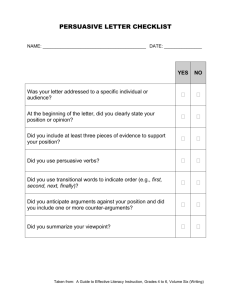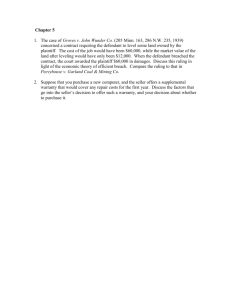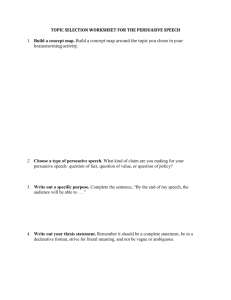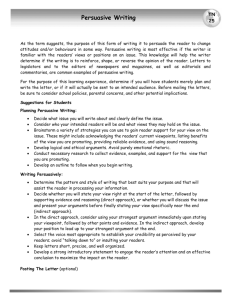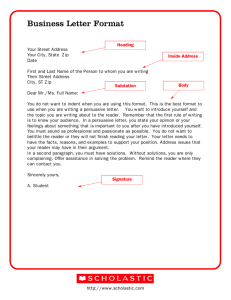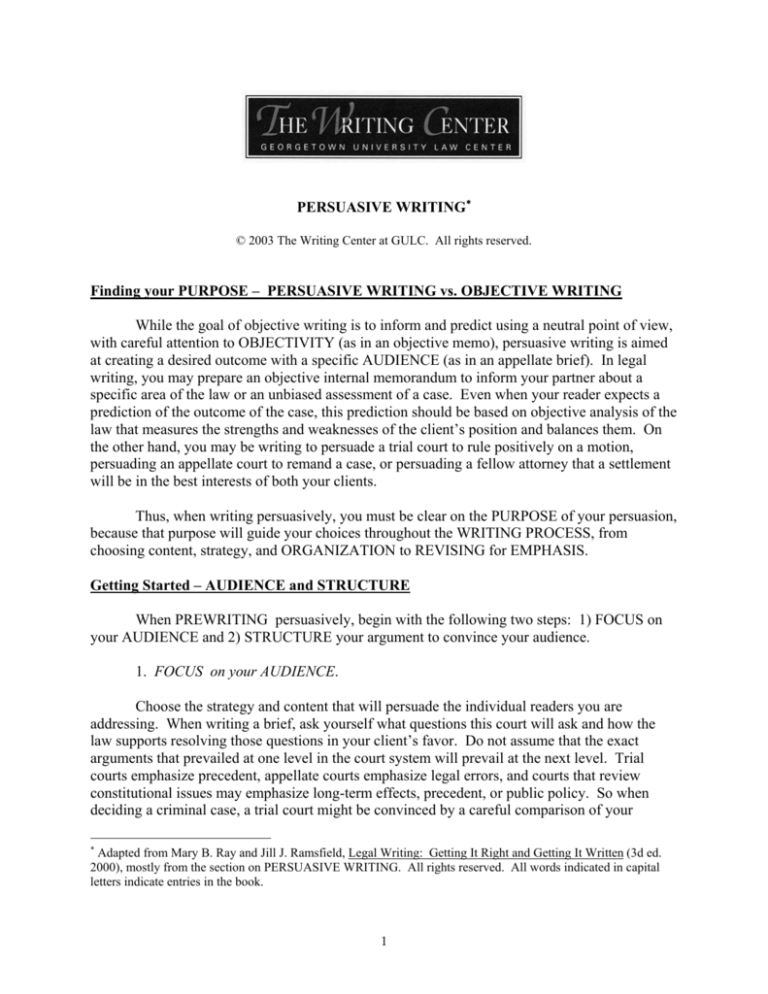
PERSUASIVE WRITING∗
© 2003 The Writing Center at GULC. All rights reserved.
Finding your PURPOSE – PERSUASIVE WRITING vs. OBJECTIVE WRITING
While the goal of objective writing is to inform and predict using a neutral point of view,
with careful attention to OBJECTIVITY (as in an objective memo), persuasive writing is aimed
at creating a desired outcome with a specific AUDIENCE (as in an appellate brief). In legal
writing, you may prepare an objective internal memorandum to inform your partner about a
specific area of the law or an unbiased assessment of a case. Even when your reader expects a
prediction of the outcome of the case, this prediction should be based on objective analysis of the
law that measures the strengths and weaknesses of the client’s position and balances them. On
the other hand, you may be writing to persuade a trial court to rule positively on a motion,
persuading an appellate court to remand a case, or persuading a fellow attorney that a settlement
will be in the best interests of both your clients.
Thus, when writing persuasively, you must be clear on the PURPOSE of your persuasion,
because that purpose will guide your choices throughout the WRITING PROCESS, from
choosing content, strategy, and ORGANIZATION to REVISING for EMPHASIS.
Getting Started – AUDIENCE and STRUCTURE
When PREWRITING persuasively, begin with the following two steps: 1) FOCUS on
your AUDIENCE and 2) STRUCTURE your argument to convince your audience.
1. FOCUS on your AUDIENCE.
Choose the strategy and content that will persuade the individual readers you are
addressing. When writing a brief, ask yourself what questions this court will ask and how the
law supports resolving those questions in your client’s favor. Do not assume that the exact
arguments that prevailed at one level in the court system will prevail at the next level. Trial
courts emphasize precedent, appellate courts emphasize legal errors, and courts that review
constitutional issues may emphasize long-term effects, precedent, or public policy. So when
deciding a criminal case, a trial court might be convinced by a careful comparison of your
∗
Adapted from Mary B. Ray and Jill J. Ramsfield, Legal Writing: Getting It Right and Getting It Written (3d ed.
2000), mostly from the section on PERSUASIVE WRITING. All rights reserved. All words indicated in capital
letters indicate entries in the book.
1
client’s facts to the facts of previous cases; but an appellate court reviewing the same case might
be convinced only by arguments that the trial court erred in its reasoning.
2. STRUCTURE your argument to convince your audience.
Choose the STRUCTURE that is most logical and convincing to this audience. When
ordering your issues, begin with the threshold issue if there is one; do not violate the reader’s
sense of logical progression. But if issues are independent, then begin with your most
compelling argument for a strong first impression. If one of three arguments is weaker than the
others, place it between the others, so that it is not emphasized by being in either the first or the
final position.
When stating and presenting each issue, begin with an affirmative statement of your
position.
The plaintiff provided adequate warning. Twice he tried to reach the defendant by
telephone before leaving messages when no one answered.
Avoid letting your opponent’s arguments dictate your structure; use the structure that best suits
your position.
Within PARAGRAPHS and PARAGRAPH BLOCKS, subordinate their arguments
through careful use of subordinate clauses (SUBORDINATION), subheadings, or paragraphs
placed in the middle of a larger paragraph block. Retain your focus on your client’s position.
Although you may need to refer to your opponent’s position in the course of your argument, do
not dwell on it. Beginning with a statement of the opposition’s position would create a
defensive tone and make your organization dependant on the other side’s position.
The plaintiff gave adequate warning. She telephoned repeatedly and left messages
on the defendant’s answering machine on two occasions.
rather than
The defense argues that the plaintiff gave no warning. This is not the case, however,
because the plaintiff left messages on the defendant’s answering machine on two
occasions.
While the latter example is not incorrect, it de-emphasizes your client’s position.
Drafting and Revising with Persuasion in Mind
Revising persuasively involves using specific techniques that marry substantive concerns
with decisions about syntax. None of these alone makes an obvious difference, but all of them,
when working in harmony, create a masterful piece of persuasion. Each technique takes practice
to master, so choose two or three from the following list and incorporate those into your writing
habits.
2
1. Use subjects and verbs for specific effect – Put your main point in the main subject
and verb in your sentence; conversely, de-emphasize points by putting them in
dependent clauses:
Although the defendant had not come to a full stop at the official stop sign, he
had slowed to less than five miles per hour and was not accelerating at the time
of the accident.
(Emphasizing that he had slowed and was not accelerating.)
2. Use concrete words – Concrete words create clearer images in the reader’s mind than
abstract ones, and those clearer images are more memorable. This tool is especially
useful in drafting fact situations in a brief, as you can use concrete words for facts
that favor your client and abstract emphasize words for facts that you want to deemphasize:
1965 black Stingray
vs.
vehicle
3. Choose the most appropriate term of address – Choose either concrete or abstract
nouns to address the parties involved, depending on whether or not your client is a
sympathetic figure:
Mrs. Jones and Julia Easley (to remind your reader of the real people involved)
or
Plaintiff and Defendant (if the facts are not sympathetic to your client and you are
making an argument based on the impersonal logic of law)
Caution! Be consistent with the kind of term you choose to use; using Ms. Easley for
the defendant but then using Plaintiff for the other side might be confusing or
obviously biased.
4. Repeat key words – Repeat words for emphasis, especially in the argument section of
a brief; make sure the word you are repeating is indeed one you do want to emphasize
(for example, repeating clearly creates a distraction, not effective emphasis):
The defendant abused the privileges offered him; he abused the procedures
designed to protect him.
Caution! Remember that the effect of a repeated word grows exponentially, rather
than linearly; don’t overdo it.
5. Repeat sentence or phrase structures – Creating a sense of rhythm and anticipation,
this tool is particularly useful and subtly dramatic in conclusions and sometimes in
fact sections:
3
At best, the City confused its argument by trying to do too much without a full
explanation. At worst, the City contradicted itself by misapplying the law.
Caution! Remember that repetition can turn to boredom, so avoid overdoing it.
6. Adjust sentence length – Short sentences are emphatic. Therefore, use them for
points you want to emphasize, but do not use them for unimportant points. This tool
can be used in fact situations and in arguments:
Julia was uniformly described by all the witnesses who had personally known
her as a strong-willed, positive and independent woman. The plaintiff himself
called her “independent and abrupt.”
or
The major purpose of the trial court’s established procedures is to give the
litigants a fair opportunity to address their claims and have them resolved by a
court of law. That purpose was met here. The petitioners here had eight years
of opportunity. In this context, their arguments on appeal are particularly
specious.
Caution! Several short sentences in a row create a choppy, rather impatient or angry
tone; while this can sometimes have a useful effect, three sentences is about as far as
you should push the series. Any more, and the court might sense an intemperate
tirade.
7. Insert information into a sentence with care – Placing a point at the beginning or end
of a sentence can either set the stage for a punch line or de-emphasize the point like
an afterthought, respectively:
Despite the difficulty of this test, the gravity of the situation required that it be
done.
or
The minority arrived at the same conclusion, although for different reasons.
Caution! Be careful that the word at the end of the sentence is not one you want to
de-emphasize, or your reader might overlook it as a signal to an upcoming point.
8. Place key phrases at the beginning or end of a paragraph or a sentence – Similarly,
words at the beginning or end of a paragraph or sentence get more attention than
those in the middle (you never know if the busy and often-interrupted legal reader
will finish reading your document with care). Avoid starting a paragraph with dates
or case names unless you have a reason to emphasize that date or name:
4
Evidence of this concern showed up in the defendant’s letter dated January 12,
1980, which stated…
rather than
On January 12, 1980, the defendant wrote a letter that showed evidence of this
concern when it stated…
9. Use subtly, rather than overly, emotional language – Choose words precisely to fit
the persuasive approach you are taking and that fall closer to the center of a
continuum between extremely positive and extremely negative:
Julia Easley was on a large and complex daily regimen of drugs, including…
rather than
Julia Easley was drugged into a vegetative state daily.
(Write the latter only if your facts establish that as her literal state.)
Caution! Avoid overly emotional language that will draw your reader’s attention to
the emotional level of the writing itself, rather than to content of the persuasive
argument (e.g., using words like blockhead or disaster can impair your credibility
where your opponent can point out the silliness of the overstatement). Also, words
that have emotional overtones, such as derelict or nuisance, are legal terms of art that
must be used with precision, whether or not the emotional overtone is appropriate.
10. Play one persuasive technique against another – As you are applying these tools, you
may find some contradictions; applying one principle means you violate another.
Practice playing these techniques against each other to get just the effect you want.
11. Avoid overdoing – Any of these persuasive techniques can be overdone. If you tend
to overdo, take the Marilyn Monroe approach to paring down: just as she removed
the accessory that caught her eye in the mirror as she walked out the door, as you read
over your last draft of a persuasive piece, take out the most obvious persuasive tool
you have used. After all, it worked for Marilyn. Few would have called her
overdressed.
5
Other Resources
For a more thorough discussion of persuasion in briefs, see:
-
Mary B. Ray and Barbara Cox, Beyond the Basics: A Text for Advanced Legal Writers
(2d ed. 2003).
For an overview of techniques used in advocacy, see:
-
Board of Student Advisers, Harvard Law School, Introduction to Advocacy: Research,
Writing, and Argument (6th ed. 1996).
6

